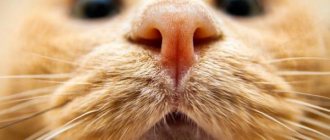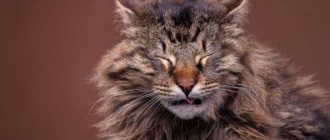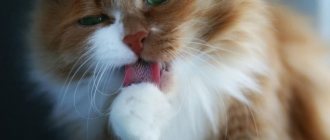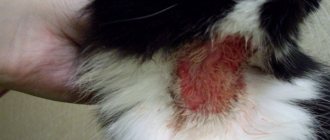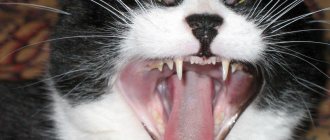How to remove crusts on a cat's nose?
A cat's nose is one of the main indicators of health. It can be used to determine the general condition of the pet. Ideally, it is slightly damp and cool. Crusts on a cat’s nose, dryness, and increased temperature indicate a possible illness. Let's find out what could be the cause of the pathological condition.
The cause of the appearance of crusts on the mucous membranes of an animal can be some diseases, physical damage and simple pollution. Cats are very clean and always take care of their bodies.
Dirt (crackers, food debris) can stick to the spout and dry out. But usually such phenomena do not last long.
Wipe your pet's nose with a damp soft cloth - if the crust is gone and there are no lesions underneath, there is no need to worry.
Infectious diseases
There are infectious diseases that affect the mucous membranes of animals.
Fungal infections (dermatomycosis)
The most common types of fungi that parasitize the nose of cats and dogs are actinomycosis, cryptococcosis, and candidiasis. The cause may be contact infection (from soil, food, sick animals), decreased immunity.
The fungus can affect not only the nose, but also other sensitive places: ears, paws (especially between the pads), stomach, eyelids, genitals. The crusts on the nose of a cat of fungal etiology are usually light-colored and flaky.
Sometimes - mixed with a small amount of blood and pus. Associated symptoms:
- Sneezing, coughing.
- Rash on the abdomen;
- Itching (cat scratches nose).
- Change in body temperature.
- General malaise: poor appetite, low activity.
Some mycoses occur with few symptoms or develop for a very long time.
Calicivirus
This is a viral disease that affects the mucous membranes, mainly the mouth, nose, and eyelids. Transmitted by contact. Signs of calicivirus:
- Formation of ulcers and erosions on the mucous membranes (when they dry out, crusts remain).
- Conjunctivitis.
- Redness, inflammation of the mucous membranes.
- Shortness of breath (when the mouth is affected).
- Refusal to eat, lethargy, weight loss.
- Temperature increase.
Over a long period of time, the virus causes inflammation in the joints. The animal begins to limp and moves little.
Bordetellosis
A bacterial disease transmitted by contact. Bacteria can be found in water, food, rotting materials, and soil. Most often, cats become infected with bordetellosis from each other. Symptoms:
- Brown crusts on the cat's nose, cracks, sores.
- Purulent discharge from affected tissues.
- Increased body temperature.
- Swelling of the lymph nodes.
- Dyspnea.
- Cough, sneezing.
- Loss of appetite, lethargy.
If persistent and clearly painful crusts appear on your pet’s nose, it is imperative to undergo diagnostics to determine an accurate diagnosis. All of these diseases are highly treatable. As therapy, medications are prescribed for oral administration, ointments and tinctures to eliminate skin manifestations. The animal may also be prescribed vitamins to strengthen the immune system.
Important!
Self-medication in such cases is unacceptable and even dangerous. Some diseases, especially fungal diseases, are transmitted to people. The cause should be found out as soon as possible and treatment should begin.
Photo of crusts on a cat's nose
Sores on the nose do not always appear in cats due to infection. There may be other reasons.
Allergy
Artificially bred cat breeds are the most susceptible to allergies. An atypical reaction of an animal’s immune system most often occurs to:
- Food (preservatives, dyes, some additives in food).
- Plants, especially during the flowering period.
- Household chemicals used in the home.
- Synthetic pillows, bedding, toys.
- Tray filler.
- Dust.
- Harmful fumes (especially if there is smoking in the house).
- Some medications.
Injuries
A cat has a dry crust on its nose as a result of an injury received in a street fight. Small, not yet intelligent kittens often scratch themselves while playing. The cat may also hit its nose on a hard object or unsuccessfully jump from a height. With a severe head injury (concussion), the following symptoms are possible:
- Impaired coordination of movements.
- Profuse bleeding from the nose.
- Vomit.
- Visual impairment.
- Loss of consciousness.
- Cramps.
Note!
In these cases, it is necessary to urgently take the pet to a veterinary clinic and have a head photograph taken to avoid severe consequences of a traumatic brain injury.
If you find crusts on your cat’s nose, do not hesitate and contact a specialist. The veterinarian will conduct tests, select procedures and medications depending on the animal’s condition for effective treatment of the pathology.
Source: https://veterinariya.com/korochki-na-nosu-u-koshki.html
Physiological causes of fever
During sleep, the nose dries out and its temperature rises. But as soon as the cat wakes up and washes itself, the surface of the nose returns to its normal state.
In a stuffy room with dry air, pets will also have a hot and dry nose. Regular ventilation of the house will make the living conditions comfortable for both owners and animals.
The nose and ears can become hot if the body is dehydrated; there should always be fresh and clean water in the cat's drinking bowl. Walking in the sun can also lead to a dry nose and a temporary increase in body temperature.
The cause of an increase in body temperature can be active play, fear and severe stress. The cat copes with such short-term changes on its own. If the animal behaves calmly and eats normally, then the owner should have no reason to worry.
Kitten has black discharge from nose
Discharge from your pet's eyes is normal if it is clear and small in number. You should be wary if you notice black discharge from your cat's eyes.
Transparent liquid in the eyes may appear as a result of a reaction that protects the animal’s eyes from environmental factors (wind, dust). The same reaction can occur if an irritant gets into your pet’s nose.
In Persian cats, lacrimation occurs after sleep. This is due to the structural features of their heads. That is, if the animal feels well and the fluid released from the eyes is clear, then the cat is healthy.
If it has acquired a certain shade, then it’s time to start worrying.
Causes of black discharge from a cat's eyes
If an adult cat has black discharge in her eyes, this may indicate that she has various diseases. There are several reasons for such deviations :
- Respiratory infection.
- Herpesvirus.
- Chlamydia.
- Ask someone for help . Have one participant wash the eyes while the other holds the animal tightly.
- Take a clean cotton swab . Wet it with solution, decoction or water.
- If your pet's eyelids are stuck together , first gently moisten them with the solution until they open.
- Blot sticky eyelashes with a damp swab in the direction from the nose to the corners of the eyes.
- Squeeze the liquid collected in the tampon into the cat's eye.
- List of forums ‹ General forums ‹ Veterinary
- Change font size
- For print
- FAQ
- Registration
- Entrance
Injury to the eye can also cause black discharge. Without proper treatment, the eyes may begin to fester. The reason for this is infection. If the secreted substance turns brown, then the cat has an obstruction of the nasolacrimal duct.
Is black discharge from the eyes of cats dangerous?
In itself, black discharge from a cat’s eyes does not pose any danger and does not affect its vision. However, they become a signal that your pet may have health problems.
Despite the fact that the animal may be in its usual condition, you need to seek help from a veterinary center.
To make a diagnosis, the veterinarian will order an eye wash test.
Diagnostics also includes a visual examination of the animal. In this case, mechanical tissue damage may occur.
If a part of the visual organ, such as the cornea, is damaged, the discharge will be brown. The animal may feel discomfort or pain. This is easy to notice by his behavior.
Restlessness, frequent blinking or squinting of the affected eye is a reason to immediately contact a veterinarian.
How to cure a cat
In addition to treating the underlying disease, the symptom of which is increased secretion of the lacrimal glands and a change in their color, attention should be paid to the hygiene of the visual organs.
You can remove black discharge from a cat’s eyes using solutions of furatsilin or boric acid. They will not only cleanse dirt, but also provide an antibacterial effect. Solutions can be replaced with strong tea, chamomile infusion or just warm water.
In some cases, the cat is prescribed antibacterial drops.
Instructions for use of solutions
To ensure that the animal is not in pain and that the procedure is effective, you need to take a responsible approach to eye rinsing. To do this you need to adhere to the following rules:
Tampons must be wet. Dry cotton wool can further injure the damaged eye. It is better to use warm solutions. Please note that if your pet has black discharge in his eyes, there is no need to self-medicate. You may harm your cat's health. Contact your veterinarian immediately for a correct diagnosis and treatment.
The cat has a black nose
If the owner notices a black nose on a cat, he should think about the health of his pet. The fact is that an animal that does not have diseases should have a clean and slightly moist nose. Only after sleep does this organ have a higher temperature and is dry. Therefore, any signs of sores, scabs, discharge or even anything that looks like dirt should be a cause for concern.
Why is the nose black
Among all the possible reasons for such a deviation, several main ones can be identified. These are: The exact prerequisites for the appearance of such a symptom can only be determined by a professional. However, for those who prefer home treatment, there are some special signs. The first reason for the formation of a crust on a cat’s nose can be a common injury. The fact is that the coat in this area of the cat is quite thin and delicate. Therefore, getting seriously injured is not that difficult. You should examine your pet, because ordinary dried blood can give a black color. It can be removed with a regular damp cloth or cotton wool. If under the crust the nose is of a normal color, you don’t have to worry about the consequences for the animal. If the kitten is simply scratched, you should not try to get rid of the rough skin. It will fall away on its own. Of course, the exception is cases when such a crust blocks the airways. Here you need to help your cat. Of course, only a specialist can provide proper care in this case. If a cat has a black spot on its nose, which is accompanied by discharge, we can draw conclusions about the presence of more serious diseases. Here you can suspect rhinoinfection, tracheitis or even calicivirus. In this case, other symptoms will appear. The cat may become more lethargic, lose appetite, and show inactivity. Among other things, you may notice that the pet begins to sneeze frequently and rub its face with its paws. Sometimes the disease appears as white or green purulent discharge from the eyes. If such signs appear, you should immediately contact a veterinary clinic. Only a doctor can diagnose and prescribe the correct treatment.
Skin diseases
If a kitten has black crusts in its nose accompanied by skin lesions near this organ, this indicates the viral nature of the disease. It could be a simple bacterial infection or a fungus. In this case, the cat clinic must undergo the necessary tests that will determine what is wrong with the pet. It is important that such diseases can easily be transmitted to humans. If such symptoms are detected, hygiene procedures should be carried out as carefully as possible and it is advisable to minimize contact with the animal. Black spots on a cat’s nose or other place are always a reason for diagnosis. If this symptom appears on the chin, for example, it may indicate acne. Of course, you don't have to rush to the clinic the same day, but you can't ignore such a serious problem. Regardless of whether symptoms other than blackheads or spots appear, it is important to provide your cat with proper care. This will keep your pet healthy. With such care the cat will live for many more years.
Elena Borisovna » May 29, 2010, 4:21 pm Kolbastt » May 31, 2010, 11:18 am Persians and exotics often have discharge in the eyes due to shortened tear ducts. Apparently, infection added to these problems. In such cases, tests are performed, the type of infection is determined, and only then treated. You independently decided to inject and give strong medications without any reason and without a system, which only made things worse. Tests cannot be taken now; they will be uninformative. Wait three weeks, then see a doctor, get tested and get treatment. MushikI » June 01, 2010, 14:25 Elena Borisovna » June 03, 2010, 08:57
Re: Brown discharge from the eyes and nose of a cat
Marina Polezhaeva » June 24, 2010, 01:54 Nina Sergeevna » June 24, 2010, 12:53
Brown discharge from the eyes and nose, etc.
Brown discharge from the eyes and nose, etc.
31.10.11 19:29 Hello! Please help us decide on a program of action for treating cats. We have 2 kittens, brother and sister, Selkirk Rex breed, 6.5 months. (Dad is British, mom is Selkirk.) The cat is semi-longhaired, the cat is shorthaired. From the very beginning that we took them (from 2.5 months), we have observed discharge from the eyes and nose, drying out with a brown crust. The cat's eyes bleed more (but the fur is longer), and the discharge looks reddish. There was a period of time when both had loose stools and feces in the blood (the last drop), now it’s more than 2 months. stool is normal. We didn’t do any vaccinations, we dewormed it once with Dirofen-suspension, we didn’t see anything in the stool, the blood didn’t go away then, it returned to normal on its own. Anandin and Maksidin were dripped for the eyes. While they were dripping, it seemed that there was an improvement, but after finishing the course everything resumed. Twice I observed something like shortness of breath in the cat (as if an asthma attack?), picked it up, everything went away. We feed Royal Horse Kitten 36 dry food and 1 pack/day for two of similar wet food. Weight for age, active, good appetite. Dad and kitten from the same litter died of FIP. Therefore, we protect the kittens from stress as much as we can, we haven’t had vaccinations, we don’t take them to the doctor. We understand that this may be it, but if not, we don’t want to sit idly by. Due to the fact that the guys are getting older, the symptoms do not go away and it is necessary to do spaying/neutering, we have the following questions: 1. What are the symptoms like? What tests need to be done to minimize frightening of the kittens, but still be able to make a diagnosis (preferably at home)? 2. How to care for your eyes and noses? (Now we just wipe with a damp cotton pad.) 3. We want to sterilize one of them first in order to give the second one a chance to get stronger. Who comes first - the cat or the female cat? (Which operation is more stressful, perhaps some other behavioral gender things need to be taken into account.) 4. How dangerous are such operations in our case? If you give anesthesia at home and take it to the clinic when you fall asleep, will this somehow affect your stress level? 5. Natural or food? 6. Should I get vaccinated? We don’t let them leave the house, but in general, someday we would like to take them to the dacha. 7. Any additional recommendations for keeping cats with our history. Thank you very much in advance for your answers!
re: Brown discharge from eyes and nose, etc.
31.10.11 20:12
go to this topic, the Doctor who deals with these problems answers there, ask her for advice /forum/?tid=15&tem=147251
re: Brown discharge from eyes and nose, etc.
04.11.11 08:43
Hello. 1) Test stool for coronavirus, protozoa, and swabs from the eyes and nose for chlamydia, mycoplasmosis, and rhinotracheitis. 2) Before the test results, you can wipe your eyes with chamomile decoction. 3) Both operations are equally stressful. 4) Giving anesthesia at home and taking it to the clinic is not the best option. 5) Continue feeding the food for now.
6) Take the necessary tests and then you can decide on the timing of vaccination.
Only registered users are able to respond to messages. Register and log in to the site by entering your username and password on the right side of the window, and you will be able to respond to messages.
Before joining the forum, read the topic: “How to vet correctly.
doctor”, as well as a list of
answers to frequently asked questions , this will help you save your time and get an answer to your question faster.
Pay special attention to the document: Symptoms of animal diseases. Perhaps in your situation you cannot expect an answer on the forum, but you need to urgently call a doctor or take the animal to a veterinary clinic!
Black discharge around the nose and on the lip
Ru-cats advised me to apply here, so here I am: we have a selected 8-month-old, neutered.
The vet discovered an ear mite, we are going to treat this with Stronghold and wiping the ears.
But there is another problem: our cat always has a black something drying around his nose, and the same strange substance is drying in two more places, on the upper and lower lip (spots about 3 millimeters in diameter), the veterinarian said that it’s a fungus (scraping and he didn’t do any tests), ordered to treat with peroxide, then scrape off the blackness with a sharp object and spray an antifungal spray on these places (the spray was prescribed by a human, judging by the annotation, for the legs.). We honestly carried out this procedure for 5 days, but we had strong doubts; not only did scraping off the blackness clearly not make him happy, but he constantly licked this spray from his nose and lips, and the nose itself, it seemed to us, began to swell. I confess, we were afraid that we were doing something wrong, and we stopped the procedures. There is less blackness near the nose now, but it continues to dry out on the lips.
Maybe you can tell us what to do, keep spraying? The problem is that we have not yet found the opportunity to send scrapings for analysis; all the local veterinary clinics that we visited do not have laboratories. Thank you in advance.
Source: https://zdorovoe-dykhanie.ru/u-kotenka-iz-nosa-chernye-vydelenija/
Nasal discharge in cats: causes and treatment
The domestic cat is a fairly independent creature that does not require special care. However, this does not mean that cats do not get sick. It is easier to “stop” any disease at an early stage. Nasal discharge is one of the most common first symptoms of many diseases.
Is nasal discharge a cause for concern?
If your cat's sneezing and/or nasal discharge is minor and she has a normal appetite and activity level, you just need to monitor her condition. To be on the safe side, it is better to isolate a cat with a “running” nose from other animals.
Chronic nasal discharge is a common symptom of viral and bacterial infections and should be taken seriously. However, most often, nasal discharge is associated with food or seasonal allergies.
If you observe watery discharge accompanied by sneezing, it usually means your cat has ingested or inhaled an allergen from the environment. Allergies to non-food irritants, also known as atopy, were most likely inherited by your cat from her parents.
Note! Atopic allergy is an increased sensitivity to common allergens: plants and their waste products, mold, insect bites and dust mites, etc.
Viral or respiratory diseases in cats
Thick and mucous discharge is a sign of a respiratory infection. It is important to understand that there are a lot of such infections and the diagnosis must be made by a veterinarian.
Viral diseases of cats that cause rhinitis:
A bacterial infection can cause chronic nasal discharge. If the discharge is thick, yellow and has an unpleasant odor - a bacterial infection, this is the most likely diagnosis.
Regardless of whether the infection is viral or bacterial, the first discharge is watery and thin, and after 24–72 hours it becomes thicker, colored, and may acquire an unpleasant odor. In advanced stages of the disease, purulent discharge is observed.
Common causes of sneezing and chronic rhinitis in cats:
The cause of nasal discharge that periodically appears and goes away may be worms. Moreover, there are parasites whose eggs mature in the respiratory tract. The larvae hatch and begin to move, which irritate the respiratory tract, causing coughing, nasal discharge, sneezing and general malaise.
Secondary chronic rhinitis in cats
Cats are created to be unique and versatile. Wild animals keep their senses and teeth constantly clean. Domestic cats receiving an adapted diet do not have this opportunity. It is for this reason that more than 80% of cats over the age of 6 suffer from:
- Caries.
- Tartar.
- Various gum diseases.
Dental problems are a common cause of chronic nasal discharge in cats. Contact your veterinarian if you observe the following symptoms:
- Careful chewing or refusal to eat.
- Salivation.
- "Champing."
- Unpleasant odor from the mouth.
- Discharge from the eyes.
- Cough.
- Temperature increase.
- Ulcerative gum disease.
Another alarming symptom is noisy breathing through the mouth. Most often, open-mouth breathing indicates complete blockage of the nostrils. A similar picture can be observed when:
- Nasal congestion.
- Reporting.
- Neoplasms, including polyps.
Nasal infections can affect both your cat's overall health and her sense of smell. Nasal infections of a viral and bacterial nature can be “identified” by the following symptoms:
- Sneezing.
- Souring of the eyes.
- Refusal of food.
- Fever.
- A sharp decrease in activity.
Copious nasal discharge is observed with the following viral diseases:
- Herpes.
- Rhinotracheitis.
- Plague.
Note! Nasal discharge may be the first symptom of conjunctivitis, as the mucous membranes of the eyes and nose “communicate.”
In what cases is the help of a veterinarian needed?
- Sneezing and nasal discharge for 3 or more days.
- Intensive deterioration of the condition - the cat sneezes more often, the nose runs more strongly.
- The color and/or consistency of nasal discharge changes.
- Green, yellow, black, or bloody nasal discharge.
- Itching in the muzzle area.
- Noisy or hoarse breathing, snoring.
- Decreased appetite and activity level.
- Vomit.
- Photophobia.
- Fever.
- Anemia of the mucous membranes.
- Noticeable deterioration in wool quality.
- The appearance of crusts, cracks, scabs on the skin of the nose.
- Discharge from the eyes.
Treatment of chronic nasal discharge in cats
After visiting a doctor and undergoing an examination, you will know why the discharge appeared. If the nature of the discharge is not viral, bacterial, infectious or fungal, a diagnosis of chronic rhinitis is made. However, this is not all; treatment is selected by trial and observation.
The veterinarian may prescribe:
- Antibiotics, decongestants, antihistamines, appetite stimulants.
- Infusion of buffer solutions.
- Tooth extraction and/or gum treatment.
- Removal of polyps, tumors or foreign bodies.
Restoring normal breathing and preventing infection are always the main goals for chronic rhinitis. Precautionary and preventative measures:
- Isolation for the quarantine period.
- Keeping the nose (and muzzle) clean - removing crusts, regularly removing remaining mucus.
- Treating the nose with special oils or ointments to maintain healthy skin.
- Regular ventilation of the room.
- Using a humidifier in winter.
- Transfer to medicated food or a more nutritious diet.
- Introduction of vitamin supplements.
- Conducting a course of immunostimulants.
- Homeopathic remedies.
- Peace and comfort.
Note! When treating rhinitis, cats are almost always prescribed vitamin preparations and lysine. The measure is associated with the widespread and high risk of infection with the feline herpes virus.
A cat may need hospital treatment if:
- The discharge has a yellow-green color and a pungent putrid odor.
- Ulcerative lesions have formed in the oral cavity.
- There is a threat of hypoxia.
- Too low or too high, unstable body temperature.
- The cat has chronic diseases of the heart, kidneys, and liver - in this case, the body may react unconventionally to treatment.
Source: https://zveridoma.ru/vydeleniya-iz-nosa-u-koshki-prichiny-i-lechenie/
Why do crusts appear on the nose of cats?
Wounds and crusts on a cat’s nose are a consequence of dermatitis, an allergic reaction or an infectious disease. At home, it is impossible to make a diagnosis on your own, since this requires a culture of the flora from the nose and an analysis of scrapings.
Nose injuries
The crusts on your cat's nose may be brownish or black. This symptom is characteristic of a fungal infection, an inflammatory process in the nasopharynx, or an allergic reaction. The most harmless cause of crust formation is considered to be household injuries.
The fact is that a healthy cat's nose is slightly moist. This prevents the normal restoration of damaged skin, so wounds can take a long time to heal.
If the owner is absolutely sure of the nature of the crusts, it is necessary to help the pet’s body recover as quickly as possible. To do this, it is recommended to treat your nose with an antiseptic several times a day.
Preventing re-infection of the wound significantly accelerates regeneration and the crusts begin to disappear a few days after the start of treatment.
A dark crust on the nose, which is accompanied by discomfort and is a consequence of skin damage, should not be a cause for concern. In this case, no treatment is required; the crust will fall off on its own when the tissues are completely restored.
Treatment with an antiseptic is only necessary if weeping erosions or crusts appear at the site of the wound, blocking the respiratory tract.
Dermatological diseases
Crusts on a cat’s nose can be the result of skin pathologies and dermatitis. These diseases are caused by fungi and bacteria. To accurately determine the cause of the formation of crusts, it is necessary to undergo a series of tests, including a nasal microflora smear and skin scraping from the affected area. The doctor will also illuminate the animal with a special lamp, which allows you to quickly determine the presence of fungal infections.
Treatment depends on the type of disease. For fungal infections of the epidermis, antimycotic drugs are used. Treatment is carried out using ointments and solutions for treating the nose. In case of a bacterial infection, the crusts should be treated with antibacterial drugs, for example, Levomekol ointment.
For dermatological diseases, antiseptic treatment of the affected area is mandatory. This is necessary to prevent secondary infection. For this purpose, a solution of chlorhexidine or miramistin is used.
Wounds and allergies
Sores and crusts on a cat's nose and around the lips may be the result of an allergic reaction. Typically, such symptoms appear in response to food allergens, but damage to the skin of the nose can be caused by contact with household chemicals.
For treatment, special antihistamine drops are used. You can buy them at a veterinary pharmacy. If the allergic reaction is moderate, it is enough to eliminate the irritant for the symptoms to subside. No specific treatment is required; it is enough to avoid contact with the allergen in the future and treat the crusts with an antiseptic to prevent infection.
Calcivirosis
If a black crust suddenly appears on your cat’s nose, you should take a close look at the animal’s behavior. One of the dangerous cat diseases is calcivirosis. Animals are usually vaccinated against this disease, but street cats that accidentally enter the house may not be vaccinated. Symptoms of calcivirosis:
- wounds and crusts on the mucous membranes of the mouth, ears and nose;
- conjunctivitis and tearing eyes;
- damage to the paw joints;
- increased body temperature;
- swollen lymph nodes;
- labored breathing.
Popular What can cause a cat to develop a rash on its stomach?
To treat calcivirosis, you should consult your doctor about the use of medications. There is no universal treatment regimen for this disease; therapy is selected depending on the symptoms and age of the pet.
Crusts on the nose should be lubricated with chlorhexidine or Lugol's solution twice a day. To make breathing easier, the nasal passages must be treated with special drops.
Source: https://KozhaKoshek.com/korki-na-nosu-u-koshek.html
Infectious diseases
If a cat has black crusts on his nose that do not heal for a long time, the cause should be sought in infectious diseases. Associated symptoms of infectious diseases:
In this case, the animal may refuse to eat and be lethargic. Particularly severe forms of infectious diseases are accompanied by vomiting, diarrhea, and dehydration.
Cat infections are very dangerous, especially if the animal does not have all the necessary vaccinations. Black crusts on the nose are one of the most harmless symptoms; in severe cases, infectious diseases can lead to the death of the pet. You cannot try to cure the cat yourself; you should take the animal to a veterinary clinic. This may require long-term hospital treatment.
Why does my cat have black nasal discharge?
" Animals "
Loading…
Question for experts: Can you tell me what it could be? The cat is already a year old. I adopted him as a one-month-old kitten (picked him up). All this time, black discharge constantly appears on the nose and eyes. Took her to the vet. He made me laugh and said “dirt.” But this is not dirt, I know for sure. The animal is white (with gray spots) and clean. I wipe it several times every day with lotion bought at a pet store, but, alas, there are no results.
Source: https://dom-voprosov.ru/zhivotnye/pochemu-u-koshki-chernye-vydeleniya-iz-nosa
Crust on a cat's nose - what triggered the symptom?
The nose is considered the main indicator of health among representatives of the cat family. If the lobe is wet, the pet is healthy.
When the tip of a cat's face is dry, it makes sense to take a closer look at the animal's health. But sometimes obscure situations arise.
Owners perceive crusts in the area of the pet's nasal passage ambiguously. Fantasy allows you to comprehend the most incredible reasons why the sore arose.
Causes
But is everything as dangerous as the brain, “inflamed” from thinking, portrays? There is no need to rush to bother the doctor and take extra money to the clinic.
First, you should figure out what caused the crusts to appear; to do this, you need to carefully examine your pet’s body.
Wounds and scabs in tailed pets can occur as a result of various events. The most common causes of crust formation on a cat's nose are:
- Injury.
- Dermatitis.
- Allergy.
- Infection.
A sore on the tip of a cat’s muzzle can take quite a long time to heal. If the owner is completely confident in the nature of the wound and knows that nothing threatens the pet’s health, he can treat the sore nose himself.
Injury
If the cat slightly hit his nose on some object, and as a result of this a crust formed on the wound, there is no need to worry too much. The sore may occur due to injury during a fight between relatives.
Thin, delicate skin is easily injured even during normal home games. The crust may represent clotted blood if the animal has had a nosebleed. Then you should monitor the condition of the fluffy.
If his breathing is normal, there are no hematomas in other parts of the body, and the scabs do not become wet, then the danger has passed.
Remember!
For speedy healing, it is advisable to treat the scabs with an antiseptic, but only if they begin to fester. If left untreated, the wound may become infected.
Then the cat's health may suffer serious consequences.
It is worth paying special attention to the fact that dry black crusts on a cat’s nose do not need to be treated.
“Cauterization” requires only weeping erosions that prevent the animal from breathing normally.
Dermatitis
Skin diseases are no less common cause of crust formation than injuries. Dermatitis is formed due to the introduction of fungi or bacteria into the epidermis of an animal. By the way, some of them can be transmitted to humans.
To identify the real pathogen, you should visit the clinic and submit a scraping for laboratory testing. In addition, the veterinarian will send the patient to the treatment room to take a number of other tests to establish the most accurate clinical picture.
A swab will be taken from the cat's nasal passage, which will determine the state of the microflora. The doctor may suggest illuminating the pet with a special lamp - the manipulation allows you to instantly determine the type of fungus. The regimen and duration of treatment depends on the established diagnosis. Fungal spores are destroyed with the help of appropriate medications - ointments, gels, creams.
Antibacterial drugs, for example, Levomekol, will help fight bacterial infection. True, the lesion, as well as the healthy tissue adjacent to it, is first treated with antiseptics. Miramistin and Chlorhexidine are suitable for cleaning. The preparatory procedure is required. After all, secondary infection can significantly worsen the condition of a sick patient.
Allergic reactions
Allergens can appear in a cat’s body in response to external stimuli:
- food products;
- household chemicals;
- flowering plants;
- veterinary drugs;
- toys, interior items made of low-quality materials;
- synthetic bedding;
- harmful emissions, tobacco smoke;
- gas pollution, dust.
The crusts on your cat’s nose will disappear on their own as soon as histamine returns to normal. To reduce the level of the “raging” hormone, you should give the animal a medicine (Suprastin, Tavegil or Diazolin). Additionally, you need to protect your pet from contact with the allergen.
Prevention
If your cat has black spots on his nose, the cause may be hidden in the dishes. This is especially true when using plastic. Change your pet's bowl. If we talk about the material, then ceramics, glass, iron are suitable. Don’t forget to change the animal’s water; this should be done at least once a day.
If your pet is prone to obesity, think about its diet. Don’t forget to strengthen the little predator’s immunity with vitamins and microelements. And if your cat is a born dirty person, do not hesitate to wash your pet.
With a little care, you can forget about your cat’s blackheads.
Still have questions? You can ask them to our site's in-house veterinarian, who will answer them as soon as possible, in the comment box below.
The cause of the appearance of crusts may be injury - the thin sensitive skin of a cat's nose is easily injured. The cat could have scratched its nose during play, in a fight with fellow tribesmen, or in an unfortunate fall from a height. Examine the animal - if no damage is visible, the cat may have had a nosebleed and the crust has formed dry. Gently wipe your pet's face with damp cotton wool - if the crusts come off easily and the skin underneath is not changed, the cat behaves calmly, breathing is not difficult, most likely, the danger has already passed, but it is better to show the animal to a veterinarian to exclude injuries to internal organs.
If a cat's nose is scratched, there is no need to separate the crust - once it dries, it will come off on its own. Do not let the cat tear off the crust while washing, and if it interferes with his breathing, soften it with warm water, chlorhexidine or Vaseline oil, remove and lubricate the exposed skin with a wound-healing preparation, preferably with antibacterial components in the composition.

